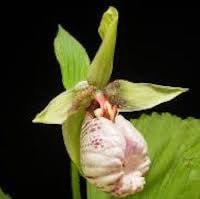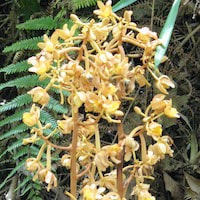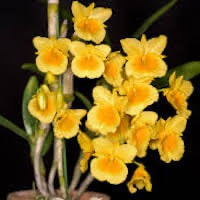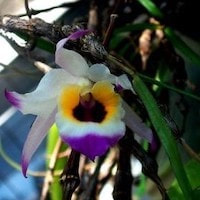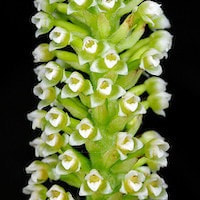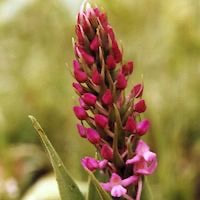MOR12- Men's Oriental 12 - Powerful you have become; the Nutmeg I scent in you
|
Native Singaporean Orchid notes: Laeliocattleya
Laeliocattleya (Lc.), a hybrid orchid genus derived from Laelia and Cattleya parental species, combines beauty, fragrance, and vibrant colors. The specific hybrid Lc Mini Purple 'Blau' x (C intermedia x L perrinii) 'Blau' highlights its unique traits inherited from blue-colored parent cultivars. Known for large, fragrant flowers in shades of purple, pink, yellow, and white, Lc. hybrids are compact, suitable for indoor cultivation. They require bright, indirect light, moderate humidity, and well-draining soil. These orchids are popular in horticulture, prized for ornamental use, including team-building perfume workshops, due to their appealing fragrance and striking appearance.
|
Therapeutic Orchid notes:
|
Cypripedium japonicum Thunb.
Cypripedium japonicum Thunb., also known as Shanmaishao Lan in Chinese and Kumagiso in Japanese, is a terrestrial orchid found across East Asia, traditionally prized for its medicinal properties. It is used in Chinese and Japanese herbal medicine to dispel wind and toxins, easing conditions like headaches and muscle pains. The herb is believed to regulate Qi flow, enhance blood circulation, and treat tertian malaria and menstrual irregularities. Its roots are also applied for pruritus, snake bites, and low backache. Prepared as decoctions or topicals, it requires careful consultation with healthcare providers due to potential interactions and dosage considerations. |
|
Cyrtosia septentrionalis (Rchb. f.) Garay
Cyrtosia septentrionalis, also known as Galeola septentrionalis, is an orchid species thriving in shaded forest understories. Adapted for self-pollination due to limited insect pollinators, it contains various chemical compounds like glycosides and phenolic derivatives. In traditional medicine, it's used to relieve muscle stiffness and spasms, treating skin sores and fungal infections when applied as a paste with vegetable oil. Its fruit decoction, mixed with liquorice, addresses gonorrhea. Caution is advised, and consulting healthcare professionals is recommended for proper usage and to avoid potential interactions with medications or health conditions. |
|
Dendrobium capillipes Rchb. f.
Dendrobium capillipes, known as Duanbang Shihu in Chinese, is an orchid species found across Asia, including Nepal, Northeast India, Yunnan, Myanmar, Thailand, Laos, and Cambodia. It contains scoparone, a compound studied for its potential to widen blood vessels, enhancing blood flow. Scoparone also affects white blood cells, stimulating lymphocyte replication while dampening immune responses. Additionally, it stimulates dopamine production, crucial for brain function. In traditional Chinese medicine, it's used under the name shihu. Caution is advised in its use, and consulting healthcare professionals is recommended due to the need for further research on its safety and effectiveness in humans. |
|
Dendrobium falconeri Hook.f. syn Dendrobium erythroglossum Hayata
Dendrobium falconeri, also known as Dendrobium erythroglossum, is a notable orchid species found in China, Taiwan, and Thailand. It features long, slender, and knotted stems. Research indicates D. falconeri contains bioactive compounds that might have potential anticancer properties, as shown in studies on human lung cancer cells. In Traditional Chinese Medicine (TCM), its stem is used to nourish yin, benefit the stomach, and alleviate heat-related symptoms like dry mouth and throat. Known as "Xin Zhu Shi Hu" in Taiwan and by various names in Thailand, caution is advised in its use, and consulting a healthcare professional is recommended due to limited research on its safety and effectiveness for medical use. |
|
Goodyera procera (Ker-Gawl.) Hook.
Goodyera procera, also known as the Spiked Rattlesnake Plantain or Tall Rattlesnake Orchid, is an orchid species used in Chinese and Taiwanese herbal medicine for various purposes. It is native to regions including Nepal, Bhutan, China, Hong Kong, and India, where it faces endangerment. In Traditional Chinese Medicine (TCM), the plant is valued for its ability to dispel wind, eliminate dampness, nourish blood, relax muscles, and relieve conditions like rheumatism, tuberculosis, and asthma. Despite its traditional use, scientific research validating these medicinal claims is limited, necessitating caution and consultation with a healthcare professional before use. |
|
Gymnadenia orchidis Lindl. Syn. Gymnadenia conopsea (L.) R.Br. var. yunnanensis Schltr.
Gymnadenia orchidis, also known as Gymnadenia conopsea var. yunnanensis, is a terrestrial orchid found in forests and thickets at elevations between 2400 to 4000 meters in China, India, and Nepal. It is known by various names such as Shouzhangshen and Xinanshoushen in Chinese, Salam panja and Salam punja in India, and Hati Jara and Panch aunle in Nepali. In traditional medicine, Gymnadenia orchidis is used widely: in India, its salep is thought to have aphrodisiac effects, while in Nepal, its pseudobulbs' powder treats wounds and stomach ailments. Chinese herbalists liken its benefits to ginseng, using it for conditions like lung weakness, impotence, and liver disorders. Despite its historical use, scientific validation of its medicinal properties is limited, urging caution and professional advice before use. |
Other scent note
Scentopia Library Reference ingredient
Cypress - Check details at Scentopia's scent library
Download the guided mediation that works best with this Orchid fragrance oil
| men_oriental_essential_oil_orchi_00012.mp3 | |
| File Size: | 111079 kb |
| File Type: | mp3 |

